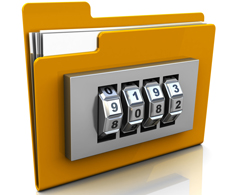Beyond Print

- Streamline Business Processes
- Improved Workflow
- Document Management
- Improve Security
- Job Accounting
- Ready to go Paperless?

Improve Security
- Improved Security
- Controlling Access
- Pull Printing
- Confidential Printing
- Encrypted Data
- Encrypted and Clean Hard Drives
Improved Security
Today, everyone’s concerned about security threats. Whether it’s keeping company information confidential or protecting your organization from outsiders looking to harm or exploit any vulnerability. Since networked print devices have the basic functionality of a networked computer or server, they are vulnerable and need to be protected. Most businesses have implemented detailed computer system security protocols, but often forget to include print devices. As you start to develop a fully integrated print strategy, there are a number of security issues that will arise. There are some basic printing technologies that can be implemented as standard printing policies by your employees. There are also a number of additional solutions that can be added on to improve your print security measures. ![]()
Controlling Access
Who gets to use the printer? When and where? Today, many businesses require people to sign-in or authenticate before they can print. Law Firms and other Professional Services firms use control access technology to require user to enter a billing code before printing or copying. Other highly secure businesses require employees to swipe smart cards, proximity cards or biometrics to gain access to their print jobs. Controlling access may be a consideration for certain departments or even specific employees as part of their day to day job functions. Increased security is easily accommodated and implemented through the use of print security technology solutions. ![]()
Pull Printing
Most businesses lock down computer access, but forget about an common security weak spot - uncollected print jobs. Often, confidential documents are left sitting on the printer unclaimed. This can be eliminated completely by implementing Pull Printing. Most new print devices use authentication at the printer to allow users to send a print job and collect it from a specific printer. Here’s how it works:
- The user sends their job to a generic print queue on the network server, including a PIN number
- The server holds the job, waiting for someone to initiate authentication from a printer on the network
- The user authenticates at any networked printer using their PIN number associated with their print job
- The authenticated print device pulls the print job from the generic queue to the printer and processes it
Pull printing technology is available through third party applications in MFPs and networkable print devices. ![]()
Confidential Printing
Private printing works the same way as pull printing, but without requiring the server. The print job is sent directly to the print device with the user associating a PIN number to the document. The user walks to the designated print device, enters the PIN number and the document is released to print. This quick and easy solution is built into most networked print devices and MFP’s and is a simple way of eliminating the need of requiring individual, personal printers for confidential documents. There is little effect on productivity since the print job is processed or “ripped” immediately but the job is held awaiting release. ![]()
Encrypted Data
If your business has security concerns about data sent over the network to print devices, there are technologies available that encrypt data as it is sent from your computer to a printer, or even data that is sent after being scanned from a print device. These encryption options add another layer of security to your print practices. ![]()
Encrypted and Clean Hard Drives
Encrypted hard drives and secure erase technology keeps stored print jobs and scans away from prying eyes. Conducting regular secure erase functions, allows network administrators to erase most print, scan, fax and copy jobs. ![]()
Establishing security protocols and implementing available security technology not only protect sensitive information but safeguards your business against unwanted intruders. Each of these functions can enhance the level required by your business to ensure data safety and integrity. ![]()